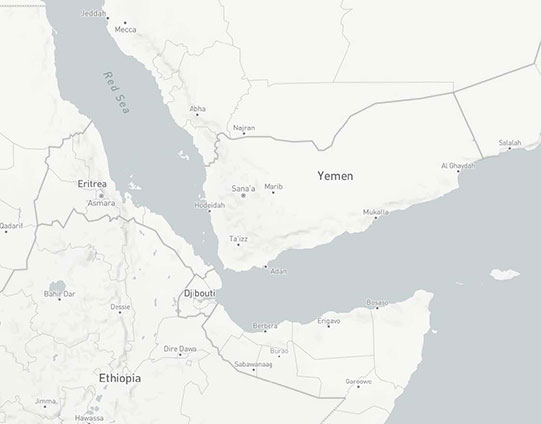Volume 27 | Issue 1
Click here to read the complete illustrated article or continue below to read the text article.
As the Israel–Hamas war continues to cause a reshuffling of Red Sea trade routes and port preferences, the short-term impact on the global supply chain seems to—surprisingly—fall short of “crises” level. Shippers are coping with the challenges despite uncertainty on how long the hostilities will last or how far reaching the ripple effects will be.
The global transportation data that flows through the Infor Nexus supply chain network technology offers interesting insights about the situation, pointing to the need for continued vigilance and scrutiny.
The Bab el-Mandeb Strait is a narrow passage connecting the Red Sea to the Gulf of Aden and a vital artery for global trade. About 15 percent of global trade and an estimated 30 percent of global container traffic passes through its waters. With the outbreak of war, the strategic value of the Red Sea came into sharp focus.
Overnight, the strait became a chokepoint. Major shipping companies suspended operations in the Red Sea fearing for the safety of crews and cargo. But rerouting vessels around the Cape of Good Hope to bypass the Bab el-Mandeb Strait brings major increases in transit times, increases fuel costs, and puts strains on other ports.
Making sense of the interconnected issues can be a challenge as the conditions change rapidly and one delay often leads to another, causing cascading responses. Fortunately, modern software can help monitor and track situations as they evolve.
Data can provide some interesting insights and unexpected trends. For example, data flowing through Infor Nexus shows a mix of transit delays, longer dwell times, and yet some projected delivery times for March are close to 2023 timeframes. Here are recent Infor Nexus observations:

Increased Dwell Times expected. In addition to shifts in transit time, dwell times at a number of the larger transshipment ports have extended; particularly those in Asia due to the extended return times to ports of origin. Particularly hard-hit is the Port of Colombo, Sri Lanka, where dwell times have doubled from four days to eight.
Cautious optimism for March. Contrary to the evidence of extended transit times, carriers are still reporting that they expect transit time levels for March to fall back to rates during November 2023 and the outbreak of the Israel- Hamas war. While the rate is still unnaturally high, the downward shift is positive news for businesses. Of the top 25 routes (by volume), only 6 show an expected increase in transit times. The China to Rotterdam route is the most heavily affected with 11 percent above the levels they were before December 2023.
The ripple effects of these disruptions are felt throughout global supply chains, proving the interconnectedness and vulnerability of the maritime trade network.
Although the long-term repercussions are yet to be tallied, we can see that the impact of the Red Sea crisis may be under control and not quite ratcheted up to crises status of infamous COVID proportions. The situation, although complex, is understandable and manageable. Organizations are able to make strategic decisions to observe, collect facts, evaluate risks, adapt, and monitor results. Technology has helped global shippers to quickly pivot in new directions. Although most industries have likely felt the ripples of disruption that originated at the Red Sea, we have not seen Pandemic-era devastating shortages, plant shutdowns, or consumer buying panics.
The “new norm” of ongoing disruptions has caused supply chain professionals to be more alert, proactive, and ready to make timely decisions, rather than take a “hope it resolves it itself” approach to response planning. Professionals in the industry have also learned the value of modern software solutions and process improvements. Here are some ways these best practices have helped mitigate the recent supply chain complications:
Emphasis on resilience. More aware of their vulnerabilities, companies are now prioritizing building robust and flexible supply chains capable of withstanding disruptions, whether from geopolitical tensions, natural disasters, or other unforeseen events.
Improved visibility. Improved visibility and predictive alerts help users get ahead of issues while there is still time to intervene and improve outcomes. Plus, network-wide views of inventory give organizations flexibility to move goods between warehouses or ship earlier from suppliers to help meet shortages.
Accelerated digital adoption. Organizations are seeing the value of digital technologies and modernizing solutions. From predictive analytics and AI-driven forecasting to supply chain mapping for traceability and automated procurement processes, companies are turning to technology to help them enhance responsiveness to disruptions and their ability to meet changing market demands.
Shift to localized sourcing. Heightened awareness of the risks associated with long and complex supply chains has led many companies to reconsider their sourcing strategies. Reshoring, nearshoring, and regionalized hubs are being adopted as companies strive to bring production closer to end markets, reduce lead times, cut transportation costs, and minimize risks associated with distant suppliers.
Interconnected ties. In an interconnected global economy, collaboration and data sharing are important. Suppliers, logistics providers, and other stakeholders are recognizing the value of transparency, communication, and risk mitigation. Enhanced visibility into inventory levels, production capacities, transportation routes, and market demand also helps organizations to be better prepared, ultimately leading to more resilient and responsive supply chains.
No one can accurately predict how long the conflict between Israel-Hamas may continue or what other volatile situations may arise. By being alert to global economic shifts as well as supply chain disruptions, organizations can make well-informed decisions based on facts, not fears or rumors. With smart strategies in place, no matter what disruption may be around the corner— or beyond the strait—the modern supply chain organization can respond with agility.
Heidi Benko, global supply chain expert, is VP of Strategy for Infor Nexus.
Scott Ellyson, CEO of East West Manufacturing, brings decades of global manufacturing and supply chain leadership to the conversation. In this episode, he shares practical insights on scaling operations, navigating complexity, and building resilient manufacturing networks in an increasingly connected world.